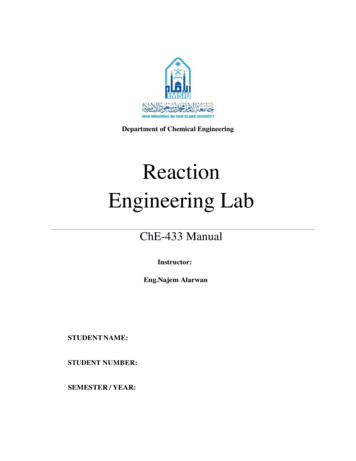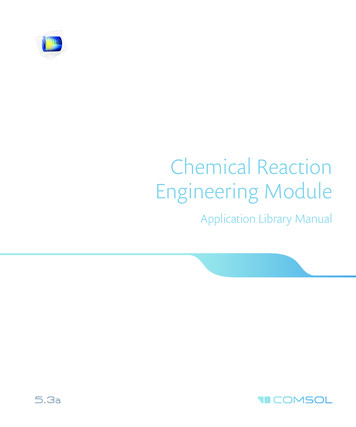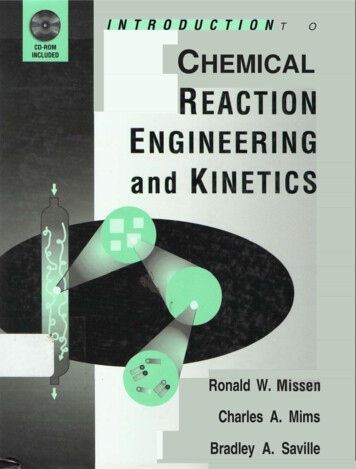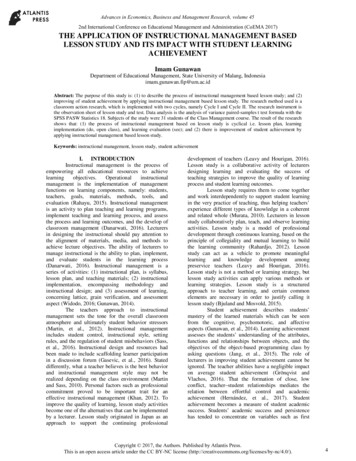
Transcription
Department of Chemical EngineeringReactionEngineering LabChE-433 ManualInstructor:Eng.Najem AlarwanSTUDENT NAME:STUDENT NUMBER:SEMESTER / YEAR:
EXPERIMENT #01 (RK-01)ISOTHERMAL OPERATION OF BATCH REACTOROBJECTIVE:1. To determine the value of the rate constant during saponification of ethyl acetate2. To demonstrate isothermal operation in batch reactor.THEORITICAL BACKGROUNDA batch reactor is normally used for small scale operation, for testing new process that has notbeen fully developed, for producing very expensive product and for processes that is difficult tobe run at continuous process.Material balance done for batch reactors results in the following governing equation:𝑑𝐶𝐴𝑑𝑡 ( 𝑟𝐴 )(1)The liquid phase reaction in this experiment is :NaOH CH3COOC2H5 CH3COONa C2H5OHFrom stoichiometry of the above reaction, we obtain relation between concentration of sodiumhydroxide (A) as function of conversion as follows :𝐶𝐴 𝐶𝐴0(1 𝑥 )(2)Assuming the reaction is pseudo first order reaction with respect to sodium hydroxide, one caneasily get 𝑟𝐴 𝑘. 𝐶𝐴2(3)Substitute eq. (2) to (3) and later substitute for –(rA) in eq. (1), one can eventually get𝑘. 𝑡 𝐶𝐴0 𝐶𝐴𝐶𝐴0 .𝐶𝐴(4)During the reaction, sodium hydroxide will dissociate into sodium ion and hydroxide ion whileethylacetate will also dissociate acetate ion and ethyl ion. Hydroxide ions will be bound to ethylions producing ethanol while acetate will be bound with sodium resulting in sodium acetate.The presence of hydroxide ions can be traced by measuring the conductivity of the solution.Thus, conversion of the reaction can be directly related to the conductivity by the followingequation:
Λ Λ𝑋 1 Λ Λ (5)0DESCRIPTION OF THE EQUIPMENTFigure 1. Batch Reactor (CE 310.04 of GUNT)1. Hole for sensor for conductivity and temperature (included in CE 310), 2. stirred tank reactor,3. stirer, 4. Chambered bottom as heat exchanger, 5. water supply, 6. product drain, 7. waterdrainEXPERIMENTAL PROCEDURE1. Solution PreparationDilution of ethyl acetate :a. Take 9.79 ml of ethyl acetate ( 0.9 g/cm3 ; Mw 88.11 g/mol) to prepare 1000 mL ofethyl acetate 0.1 M.b. Dilute it until the total volume reach 1000 mL in a 1L-volumetric flask.c. Close the flask tightly and shake it rigorously until ethyl acetate and water are completelymixed.Dilution of Sodium hydroxide :a. Take 4 g of sodium hydroxide (Mw 40 g/mol) to prepare 1000 mL of sodium hydroxide0.1 M.b. Dilute it until the total volume reach 1000 mL in a 1L-volumetric flask.c. Close the flask tightly and shake it rigorously until sodium hydroxide and water arecompletely mixed.2. Batch reactor operational procedure.a. Switch the water circulator of CE 310 trainer to maintain the temperature at roomtemperature.
b.c.d.e.f.g.h.Carefully introduce to the batch reactor (CE 310.04) 900 mL of 0.1 M NaOH solution.Observe for few minutes until the temperature of NaOH solution remains constant.Adjust the stirrer to a medium speed but do not switch it on yet.Carefully introduce to the reactor 90 mL of 0.1 M ethyl acetate.Start the stirrer and record the time.Record conductivity and temperature for 30 min.Repeat the experiment at new temperature (10 oC higher than room temperature)REFERENCESManual of CE310.04, GUNTFogler, H.S. , Elements of Chemical Reaction Engineering, 4th edition, 2007, Prentice Hall NYNOTATIONCΛkrtT::::::Concentration, kmol/m3Conductivity, Siemens/cmReaction rate constantRate of reaction, sTime, sTemperature, K
WORK SHEETStudents’ Name and ID:ID #ID #ID #ID #Temperature : oCTimeConductivityMin : secS/cmTemperatureoCTimeConductivityMin : 004:3032:00TemperatureoC
Temperature : oCTimeConductivityMin : secS/cmTemperatureoCTimeConductivityMin : 004:3032:00TemperatureoCTask (must be included in the report) :1. Determine initial concentration of NaOH solution2. Convert conductivity data into concentration of NaOH3. Plot equation (4) and comment on the plot!4. Plot temperature vs time and comment on the plot!5. Determine the reaction rate constant at the above two temperatures, determine alsoactivation energy for this reaction and compare it with literature value.
EXPERIMENT #02 (RK-02)ADIABATIC OPERATION OF BATCH REACTOROBJECTIVE:3. To demonstrate adiabatic operation in batch reactor.4. To compare the conversion achieved by isothermal and adiabatic operation.THEORITICAL BACKGROUNDA batch reactor is normally used for small scale operation, for testing new process that has notbeen fully developed, for producing very expensive product and for processes that is difficult tobe run at continuous process.Material balance done for batch reactors results in the following governing equation:𝑑𝐶𝐴𝑑𝑡 ( 𝑟𝐴 )(6)The liquid phase reaction in this experiment is :NaOH CH3COOC2H5 CH3COONa C2H5OHFrom stoichiometry of the above reaction, we obtain relation between concentration of sodiumhydroxide (A) as function of conversion as follows :𝐶𝐴 𝐶𝐴0(1 𝑥 )(7)Assuming the reaction is pseudo first order reaction with respect to sodium hydroxide, one caneasily get 𝑟𝐴 𝑘. 𝐶𝐴(8)Substitute eq. (2) to (3) and later substitute for –(rA) in eq. (1), one can eventually get 𝑋 𝑡 𝑘 (1 𝑋)(9)During the reaction, sodium hydroxide will dissociate into sodium ion and hydroxide ion whileethylacetate will also dissociate acetate ion and ethyl ion. Hydroxide ions will be bound to ethylions producing ethanol while acetate will be bound with sodium resulting in sodium acetate. Thepresence of hydroxide ions can be traced by measuring the conductivity of the solution. Thus,conversion of the reaction can be directly related to the conductivity by the following equation:
Λ Λ𝑋 1 Λ Λ (10)0DESCRIPTION OF THE EQUIPMENTFigure 1. Batch Reactor (CE 310.04 of GUNT)1. Hole for sensor for conductivity and temperature (included in CE 310), 2. stirred tank reactor,3. stirer, 4. Chambered bottom as heat exchanger, 5. water supply, 6. product drain, 7. waterdrainEXPERIMENTAL PROCEDURE3. Solution PreparationDilution of ethyl acetate :d. Take 9.79 ml of ethyl acetate ( 0.9 g/cm3 ; Mw 88.11 g/mol) to prepare 1000 mL ofethyl acetate 0.1 M.e. Dilute it until the total volume reach 1000 mL in a 1L-volumetric flask.f. Close the flask tightly and shake it rigorously until ethyl acetate and water are completelymixed.Dilution of Sodium hydroxide :d. Take 4 g of sodium hydroxide (Mw 40 g/mol) to prepare 1000 mL of sodium hydroxide0.1 M.e. Dilute it until the total volume reach 1000 mL in a 1L-volumetric flask.f. Close the flask tightly and shake it rigorously until sodium hydroxide and water arecompletely mixed.
4. Batch reactor operational procedure.a. Carefully introduce to the batch reactor (CE 310.04) 900 mL of 0.1 M NaOH solution.b. Adjust the stirrer to a medium speed but do not switch it on yet.c. Carefully introduce to the reactor 90 mL of 0.1 M ethyl acetate.d. Start the stirrer and record the time.e. Record conductivity and temperature for 30 min.REFERENCESManual of CE310.04, GUNTFogler, H.S. , Elements of Chemical Reaction Engineering, 4th edition, 2007, Prentice Hall NYNOTATIONCΛkrtT::::::Concentration, kmol/m3Conductivity, Siemens/cmReaction rate constantRate of reaction, sTime, sTemperature, K
WORK SHEETStudents’ Name and ID:ID #ID #ID #ID #TimeConductivityMin : secS/cmTemperatureoCTimeConductivityMin : 004:3032:00TemperatureoCTask (must be included in the report) :6. Determine initial concentration of NaOH solution7. Convert conductivity data into conversion of NaOH8. Plot temperature vs time and conversion vs time comment on the plot! 𝑇9. Derivefor adiabatic operation of batch reactor! (Hint: refer to chapter 8 of Fogler) 𝑡10. Using the experimental k obtained from RK-01 experiment, prepare the profile of theconversion and temperature with respect to time of this adiabatic operation and put theexperimental result on the same plot. Comment on the result! (use polymath to solvecoupled of differential equation, you may need physical properties for solving this task).
EXPERIMENT #03 (RK-03)ADIABATIC OPERATION OF BATCH REACTOROBJECTIVE:5. To determine the order and reaction rate constant for liquid phase in CSTR.6. To study the effect of flow rate on the conversion of reactant.7. To evaluate the time required to reach steady-state operationTHEORITICAL BACKGROUNDContinuous stirred tank reactor (CSTR) is one of continuous flow reactors that are normallyoperated at steady state. It is normally used for liquid phase reaction and assumed to becompletely mixed. Hence, temperature, concentration and reaction rate inside CSTR are no timedependence and position dependence. Due to that independence, the temperature andconcentration at the exit point are the same as those inside the reactor.The liquid phase reaction in this experiment is:NaOH CH3COOC2H5 CH3COONa C2H5OHMaterial balance done for unsteady state is as follows:𝐹𝐴𝑂 𝐹𝐴𝑂 (1 𝑋) ( 𝑟𝐴 )𝑉 𝑑(𝑉𝐶𝐴 )𝑑𝑡(11)From stoichiometry of the above reaction, we obtain relation between concentration of sodiumhydroxide (A) as function of conversion as follows :𝐶𝐴 𝐶𝐴0(1 𝑥 )(12)Also residence time can be calculated as follows𝜏 𝐶𝐴𝑂 𝐶𝐴( 𝑟𝐴 )(13)Assuming the reaction rate is only depending on sodium hydroxide, one can easily get 𝑟𝐴 𝑘. 𝐶𝐴 𝑛(14)Substitute eq. (2) to (3) and later substitute for –(rA) in eq. (1), one can eventually get 𝑋 𝑡2 ( 𝑘𝐶𝐴𝑂1 𝑋 )2 𝐹𝐴𝑂𝑉𝐶𝐴𝑂𝑋(15)
During the reaction, sodium hydroxide will dissociate into sodium ion and hydroxide ion whileethylacetate will also dissociate acetate ion and ethyl ion. Hydroxide ions will be bound to ethylions producing ethanol while acetate will be bound with sodium resulting in sodium acetate. Thepresence of hydroxide ions can be traced by measuring the conductivity of the solution. Thus,conversion of the reaction can be directly related to the conductivity by the following equation:𝑋 1 𝛬 𝛬(16)𝛬 𝛬0DESCRIPTION OF THE EQUIPMENTFigure 1. Batch Reactor (CE 310.01 of GUNT)1. stirred tank reactor, 2. stirrer, 3. water supply, 4. reactants A/B supply, 5. water drain, 6.product drain, 7. chambered bottom as heat exchanger, 8. sensor for conductivity andtemperature (included in CE 310), 9. height-adjustable overflowEXPERIMENTAL PROCEDURE5. Solution PreparationDilution of ethyl acetate :g. Take 39.16 ml of ethyl acetate ( 0.9 g/cm3 ; Mw 88.11 g/mol) to prepare 4000 mL ofethyl acetate 0.1 M.h. Dilute it until the total volume reach 4000 mL in a 4L-beaker.i. Stir it rigorously until ethyl acetate and water are completely mixed.Dilution of Sodium hydroxide :
g. Take 16 g of sodium hydroxide (Mw 40 g/mol) to prepare 4000 mL of sodium hydroxide0.1 M.h. Dilute it until the total volume reach 4000 mL in a 4L-beaker.i. Stir it rigorously until sodium hydroxide and water are completely mixed.6. CSTR operational procedure.a. Calibrate the actual flow rate of both pump needed in this experiment at speed scale of40 and 80.b. Measure the height of the liquid level in CSTR (inside diameter of CSTR is 100 mm).c. Connect the correct chemical hoses from the pumps to the tank.d. Insert conductivity measuring sensor in the measuring opening on the lid and connect thestirrer.e. Adjust the overflow on the tank such that the measuring sensor is immersedapproximately 50 mm in the liquid with the tank filled.f. Set required temperature for the heating regulator to 40oC and switch on the heater.g. Switch on the chemical pumps and adjust both to the same flow rate approximately80:80.h. When the liquid level reaches the overflow, switch on the stirrer and adjust to a mediumspeed.i. At every 20 seconds measure the conductivity and temperature until it reach steady state.j. Reduce the flow rate to 40:40k. At every 20 seconds measure the conductivity and temperature until it reach steady state.l. increase the flow rate to 80:80m. At every 20 seconds measure the conductivity and temperature until it reach steady state.n. Stop the reactor and clean it.REFERENCESManual of CE310.01, GUNTFogler, H.S. , Elements of Chemical Reaction Engineering, 4th edition, 2007, Prentice Hall NYNOTATIONCΛkrtT::::::Concentration, kmol/m3Conductivity, Siemens/cmReaction rate constantRate of reaction, sTime, sTemperature, K
WORK SHEETStudents’ Name and ID:ID #ID #ID #ID #80:80TimeConductivityMin : secS/cm40:40TemperatureoCTimeConductivityMin : secS/cm80:80TemperatureoCTimeMin : :005:005:006:006:006:007:007:007:00Conductivity TemperatureS/cmoC
Task (must be included in the report) :11. Convert conductivity data into conversion of NaOH.12. Linearize equation # 4 and get the value of k and n and use experimental data for thatpurpose. In order to do that (-rA) must be calculated first from equation #3.13. Plot temperature vs time for all flow rate change in one graph! Do the same for conversionvs time. Comment on the plot.14. Determine the time required to reach steady state experimentally from the above graph(step #4) for each flow rate.15. Determine the time required to reach steady state numerically by solving equation #5.16. Plot conversion vs time experimentally and theoretically in one graph, and comment onthe plot.
EXPERIMENT #04 (RK-04)OPERATION OF PLUG FLOW REACTOROBJECTIVE:8. To determine the order and reaction rate constant for liquid phase in PFR.9. To study the effect of flow rate on the conversion of reactant.THEORITICAL BACKGROUNDPlug Flow Reactor (PFR) is one of continuous flow reactors that are normally operated at steadystate. It is normally used for gas phase reaction but it can also be used for liquid phase reaction.In PFR, there is no radial variation in terms of temperature and concentration. The reactants areconsumed continuously through the reactor in axial direction.The liquid phase reaction in this experiment is:NaOH CH3COOC2H5 CH3COONa C2H5OHMaterial balance done for steady state is as follows:𝐹𝐴 𝐹𝐴 𝑑𝐹𝐴 ( 𝑟𝐴 )𝑑𝑉(17)From stoichiometry of the above reaction, we obtain relation between concentration of sodiumhydroxide (A) as function of conversion as follows :𝐶𝐴 𝐶𝐴0(1 𝑥 )(18)By taking𝜏 𝑉(19)𝜈One can modify eq. (1) into𝐶𝜏 𝐶 𝐴𝐴0𝑑𝐶𝐴 𝑟𝐴(20)assuming the reaction rate is only depending on sodium hydroxide, one can easily get 𝑟𝐴 𝑘. 𝐶𝐴 𝑛(21)
During the reaction, sodium hydroxide will dissociate into sodium ion and hydroxide ion whileethylacetate will also dissociate acetate ion and ethyl ion. Hydroxide ions will be bound to ethylions producing ethanol while acetate will be bound with sodium resulting in sodium acetate. Thepresence of hydroxide ions can be traced by measuring the conductivity of the solution. Thus,conversion of the reaction can be directly related to the conductivity by the following equation:𝑋 1 𝛬 𝛬(22)𝛬 𝛬0DESCRIPTION OF THE EQUIPMENTFigure 1. Tubular Reactor (CE 310.02 of GUNT)1. tubular reactor, 2. double jacket, 3. reactants A/B supply, 4. water supply, 5. product drain, 6. sleevefor sensor for conductivity and temperatureEXPERIMENTAL PROCEDURE7. Solution PreparationDilution of ethyl acetate :
Take 39.16 ml of ethyl acetate ( 0.9 g/cm3 ; Mw 88.11 g/mol) to prepare 4000 mL ofethyl acetate 0.1 M.k. Dilute it until the total volume reach 4000 mL in a 4L-beaker.l. Stir it rigorously until ethyl acetate and water are completely mixed.j.Dilution of Sodium hydroxide :j. Take 16 g of sodium hydroxide (Mw 40 g/mol) to prepare 4000 mL of sodium hydroxide0.1 M.k. Dilute it until the total volume reach 4000 mL in a 4L-beaker.l. Stir it rigorously until sodium hydroxide and water are completely mixed.8. PFR operational procedure.a. Calibrate the actual flow rate of both pump needed in this experiment at speed scale of20; 40 and 80.b. Connect the correct chemical hoses from the pumps to the tank.c. Insert conductivity measuring sensor at the outlet of PFR.d. Set required temperature for the heating regulator to 40oC and switch on the heater.e. Switch on the chemical pumps and adjust both to the same flow rate approximately20:20.f. At specific interval (as provided in the log sheet) measure the conductivity andtemperature until it reach steady state.g. Repeat step e-f for the flow rate to 40:40 and 80:80REFERENCESManual of CE310.02, GUNTFogler, H.S. , Elements of Chemical Reaction Engineering, 4th edition, 2007, Prentice Hall NYNOTATIONCΛkrtT::::::Concentration, kmol/m3Conductivity, Siemens/cmReaction rate constantRate of reaction, sTime, sTemperature, K
WORK SHEETStudents’ Name and ID:ID #ID #ID #ID #20:20TimeConductivityMin : secS/cm40:40TemperatureoCTimeConductivityMin : secS/cm80:80TemperatureoCTimeMin : :005:005:006:006:006:007:007:007:00Conductivity TemperatureS/cmoC
Task (must be included in the report) :17. Convert conductivity data into conversion of NaOH.18. Find from the literature what is the order and k of reaction.19. Substitute the rate law (as you obtain from the literature) to eq. 5 and solve the integral.20. Evaluate both theoretical and experimental values of conversions for each run.21. Plot experimental conversion vs space time data ad compare it with theoreticalprediction.
EXPERIMENT #05 (RK-05)OPERATION OF CSTR in SERIESOBJECTIVE:To study the effect of flow rate on the overall conversion of reactant in steady state operation ofCSTR in series.THEORITICAL BACKGROUNDCSTR in series is one of configuration of reactors that performs between single CSTR and PFR interms of volume required to achieve the same conversion.The liquid phase reaction in this experiment is:NaOH CH3COOC2H5 CH3COONa C2H5OHMaterial balance done for steady state for first reactor is as follows:𝐹𝐴0 𝐹𝐴1 ( 𝑟𝐴 )1𝑉1(23)From stoichiometry of the above reaction, we obtain relation between concentration of sodiumhydroxide (A) as function of conversion as follows :𝐶𝐴 𝐶𝐴0(1 𝑥 )(24)By taking𝜏 𝑉(25)𝜈Assuming the reaction rate is only depending on sodium hydroxide, one can easily get 𝑟𝐴 𝑘. 𝐶𝐴 𝑛(26)Substitute equation (4) and (2) to equation (1) and solve for t will give us𝜏1 𝑥1𝑛 1𝑘𝐶𝐴0 (1 𝑥1 )𝑛(27)With same approach one will get residence time for second and third reactors as follows𝜏2 𝑥2 𝑥1𝑛 1 (1 𝑥 )𝑛𝑘𝐶𝐴02(6)
𝜏3 𝑥3 𝑥2(7)𝑛 1 (1 𝑥 )𝑛𝑘𝐶𝐴03During the reaction, sodium hydroxide will dissociate into sodium ion and hydroxide ion whileethylacetate will also dissociate acetate ion and ethyl ion. Hydroxide ions will be bound to ethylions producing ethanol while acetate will be bound with sodium resulting in sodium acetate. Thepresence of hydroxide ions can be traced by measuring the conductivity of the solution. Thus,conversion of the reaction can be directly related to the conductivity by the following equation:𝑋 1 𝛬 𝛬(8)𝛬 𝛬0DESCRIPTION OF THE EQUIPMENTFigure 1. Tubular Reactor (CE 310.02 of GUNT)1. sensor for conductivity and temperature, 2. overflow, 3. stirrer, 4. stirred tank, 5. chambered bottomas heat exchanger, 6. water supply, 7. reactants A/B supply, 8. intermediate delivery, 9. product drain, 10.water drain
EXPERIMENTAL PROCEDURE9. Solution PreparationDilution of ethyl acetate :m. Take 39.16 ml of ethyl acetate ( 0.9 g/cm3 ; Mw 88.11 g/mol) to prepare 4000 mL ofethyl acetate 0.1 M.n. Dilute it until the total volume reach 4000 mL in a 4L-beaker.o. Stir it rigorously until ethyl acetate and water are completely mixed.Dilution of Sodium hydroxide :m. Take 16 g of sodium hydroxide (Mw 40 g/mol) to prepare 4000 mL of sodium hydroxide0.1 M.n. Dilute it until the total volume reach 4000 mL in a 4L-beaker.o. Stir it rigorously until sodium hydroxide and water are completely mixed.10. CSTR in series operational procedure.a. Calibrate the actual flow rate of both pump needed in this experiment at speed scale of40 and 80.b. Connect the correct chemical hoses from the pumps to the tank.c. Insert conductivity measuring sensor at the CSTR.d. Switch on the chemical pumps and adjust both to the same flow rate approximately40:40.e. At specific interval (as provided in the log sheet) measure the conductivity andtemperature until it reach steady state.f. Repeat step d-e for the flow rate to 80:80REFERENCESManual of CE310.03, GUNTFogler, H.S. , Elements of Chemical Reaction Engineering, 4th edition, 2007, Prentice Hall NYNOTATIONCΛkrtT::::::Concentration, kmol/m3Conductivity, Siemens/cmReaction rate constantRate of reaction, sTime, sTemperature, K
WORK SHEETStudents’ Name and ID:ID #ID #ID #ID #40:4080:80TimeConductivity of Tank #iTimeConductivity of Tank #iMin : secS/cmMin : 6:0020:0020:00123Task (must be included in the report) :22. Convert conductivity data into conversion of NaOH.23. Find from the literature what is the order and k of reaction.24. Evaluate both theoretical and experimental values of conversions for each run.25. Plot experimental conversion vs space time for each CSTR and compare it with theoreticalprediction.
Reaction Engineering Lab ChE-433 Manual Instructor: Eng.Najem Alarwan STUDENT NAME: . The presence of hydroxide ions can be traced by measuring the conductivity of the solution. Thus, conversion of the reaction can be directly related to the conductivity by the following . Fogler, H.S. , Elements o










